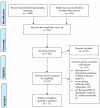A systematic review of the impact of routine collection of patient reported outcome measures on patients, providers and health organisations in an oncologic setting
- PMID: 23758898
- PMCID: PMC3700832
- DOI: 10.1186/1472-6963-13-211
A systematic review of the impact of routine collection of patient reported outcome measures on patients, providers and health organisations in an oncologic setting
Abstract
Background: Despite growing interest and urges by leading experts for the routine collection of patient reported outcome (PRO) measures in all general care patients, and in particular cancer patients, there has not been an updated comprehensive review of the evidence regarding the impact of adopting such a strategy on patients, service providers and organisations in an oncologic setting.
Methods: Based on a critical analysis of the three most recent systematic reviews, the current systematic review developed a six-method strategy in searching and reviewing the most relevant quantitative studies between January 2000 and October 2011 using a set of pre-determined inclusion criteria and theory-based outcome indicators. The Grading of Recommendations, Assessment, Development, and Evaluation (GRADE) system was used to rate the quality and importance of the identified publications, and the synthesis of the evidence was conducted.
Results: The 27 identified studies showed strong evidence that the well-implemented PROs improved patient-provider communication and patient satisfaction. There was also growing evidence that it improved the monitoring of treatment response and the detection of unrecognised problems. However, there was a weak or non-existent evidence-base regarding the impact on changes to patient management and improved health outcomes, changes to patient health behaviour, the effectiveness of quality improvement of organisations, and on transparency, accountability, public reporting activities, and performance of the health care system.
Conclusions: Despite the existence of significant gaps in the evidence-base, there is growing evidence in support of routine PRO collection in enabling better and patient-centred care in cancer settings.
Figures



References
-
- Guidance for Industry Patient-Reported Outcome Measures: Use in Medical Product Development to Support Labeling Claims. Silver Spring, Maryland: U.S. Department of Health and Human Services Food and Drug Administration; 2009. - PubMed
-
- Ousey K, Cook L. Understanding patient reported outcome measures (PROMs) Br J Community Nurs. 2011;16(2):80–82. - PubMed
Publication types
MeSH terms
LinkOut - more resources
Full Text Sources
Other Literature Sources
Medical
Miscellaneous

